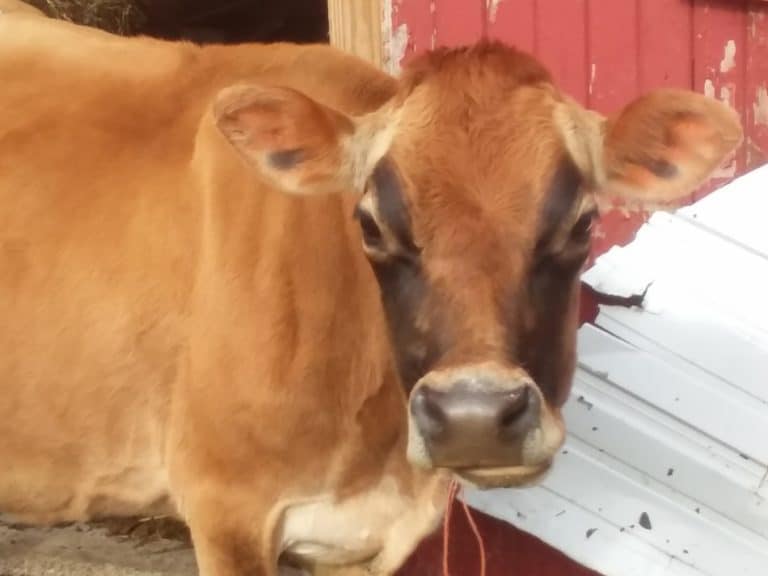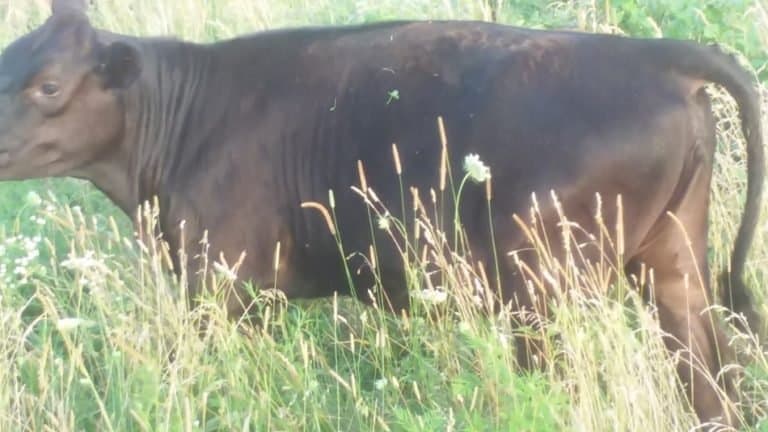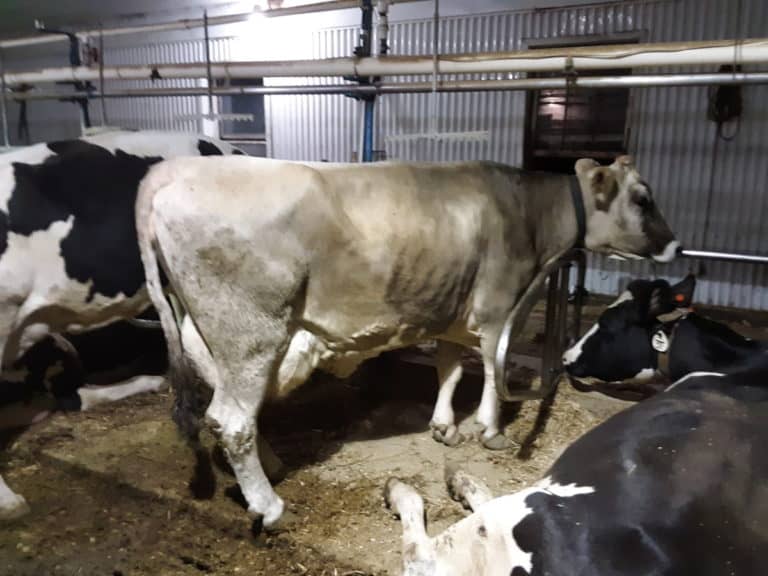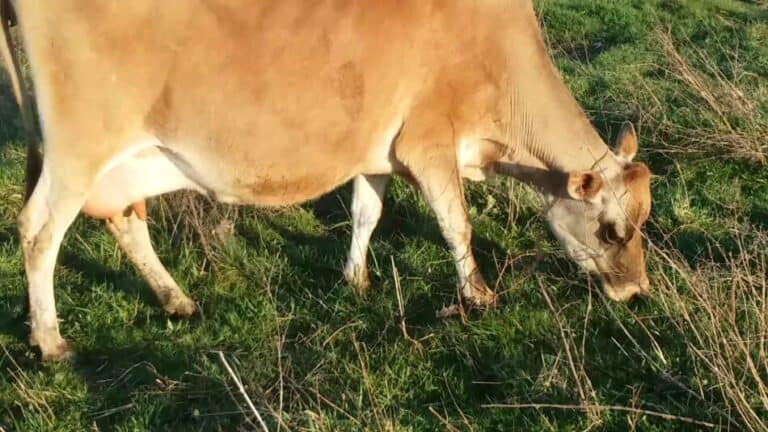Is Having A Family Milk Cow Affordable? (Budget Included)
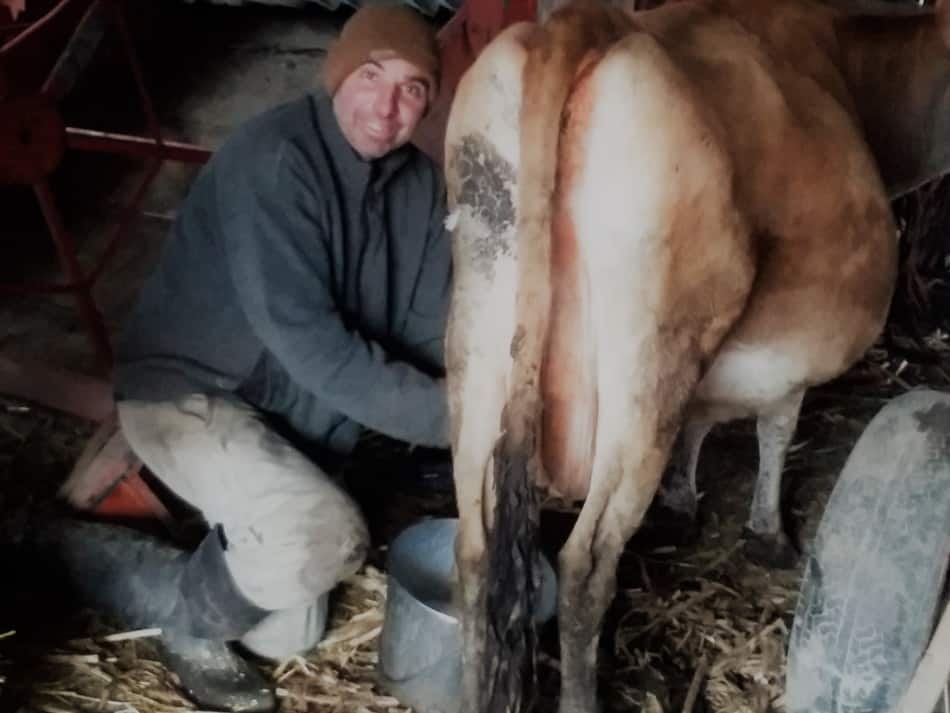
Plentiful real milk, making your own cheese and yogurt, real cream for your coffee, exciting stuff! All of this dairy goodness can be yours, when you get a family cow.
Of course it will be great to have the cow, but should you get one? How affordable is having a family milk cow?
Feeding and caring for a family cow will cost you $4.06 per day, which is $1,709.70 per year for 610 gallons of real milk. You would pay $3,050 (610 gallons x $5/gallon) to buy this from another small dairy farmer.
How do you know if you’re ready? My guide “Are You Ready For A Family Cow?” will walk you through the things you need to have figured out, including feeding needs and daily care, before you get your cow.
It’s easy to list the benefits of a family milk cow, especially for a family trying to provide more of their own nutrient dense food.
Now on to the bottom line: what should you expect to pay for on a daily and yearly basis?
And how do you figure out a budget to see if having your own milk makes money sense?
This is a link to my article outlining the costs to Buy A Family Milk Cow, listing what you need to get and look out for.
If you are looking for help and tips with breed selection, consider reading my article 5 Best Family Cow Breeds For Beginners.
Costs to keep a family milk cow
| Expenses (money you spend) | $ per day | $ per year |
| Ration | ||
| Hay at $150/ton use 365 days for hay | $2.03 | $740.95 |
| Feed 4 pounds/day at $.30/pound use 305 days for grain | $1.20 | $366 |
| vet care | $100 | |
| Bedding materials see below, we’ll use straw and year round use of bedding | $.83 | $302.95 |
| Miscellaneous small items | $200 | |
| Total costs | $4.06 | $1,709.70 |
| Revenue (money coming in) | ||
| Milk produced per day figuring low production per day | 2 gallons | 610 gallons |
| value of milk figuring $5/gallon | $10 | $3,050 |
| income from calf | $200 | |
| total revenue from cow | $10 | $3,250 |
| Total profit having a family milk cow | $5.94 | $1,540.30 |
The costs to keep your family milk cow will involve your time, feed/hay, occasional vet care and bedding.
I’m figuring that you have some sort of a building and a fenced pasture already available so I won’t be including these costs in the budget.
If you have some land, but no fence, don’t worry, cattle are easy to keep in with single strand portable electric.
Cost of your time with the cow
I did not put this line in the chart above, here’s why:
The short version: I can’t tell you how to value your time, only you can do that.
The long version (a.k.a. let’s talk about me): for me there is nothing more important than taking care of my family and our nutritional needs.
We aren’t perfect with our eating choices, not even close! That makes the need for nutrient dense foods that we do eat to be top end.
A cow spends her day gathering nutrients from plants and weeds all over the farm to process into milk.
Since I don’t want to gather up then cook all that plant material, I do it the easy way-by drinking the milk. This is the real time saver for me.
I can’t think of anything else that I can do with 20 minutes (milking for 10 minutes, twice a day) that influences our health for the future.
Our time spent milking is definitely worth it!
How do you know if you’re ready? My guide “Are You Ready For A Family Cow?” will walk you through the things you need to have figured out, including feeding needs and daily care, before you get your cow.
Cost of the cow’s ration (what she eats)
A cow needs to eat 3% of her body weight per day in roughage (hay or grass) to keep up her health and productivity.
When your cow is on grass, she will take care of figuring out the amounts for you. She’ll eat until she’s satisfied then sit and chew her cud.
Figuring out your cost to feed your cow
Here come more numbers that will vary for you, we’ll just use the cost of hay around my area.
You’ll need the cost of hay per ton and the weight of your cow (just guesstimate).
Cost of hay/pound for your area
First, we need to find the cost of hay per pound in your local area. For us a nice cow appropriate hay is going to run you $150 per ton.
A ton is 2,000 pounds. Look to hay auction results and check around online for farmers selling directly from the farm. No luck so far? Ask at the local farm store.
A completely different priced example: I stopped in at a locally run on farm feed store yesterday and their cost per bale of hay is $10. T
hat would be around $500 per ton. That’s not what I am buying, the most we’ve paid is around $5 bale.
If your will be different from mine, adjust your math accordingly.
Cost of hay/ton divided by 2,000= cost of hay per pound
$150 divided by 2,000=.075 which is 7.5 cents per pound
Figuring out the weight of your cow
You’ll need a good guess here and then adjust as you go.
Generally speaking, a smaller breed cow will be in the 850-1,000 pound range and the larger framed cattle will me more like 1,600-1,800.
Look up her breed and see what would be a likely weight.
Weight of your cow x 3%(.03)=pounds of roughage she needs per day
Our cow is on the lighter end of things in the bovine world, so we’ll say 900 pounds for Aleene.
900 x .03=27 pounds of roughage (hay) per day for Aleene
Use the two numbers above to get cost per day of hay
Now to put these two numbers together and get what it will cost you to feed your cow per day.
Hay cost/pound x pounds of roughage needed/day=cost of hay/day
.075 x 27=$2.025 is the daily cost to feed Aleene hay (We’ll round this up to $2.03 for the rest of the article)
Figuring the cost of grain for your cow
Now, on to grain. You do not need to feed grain to have a family milk cow. We don’t feed any grain to Aleene, but your cow may be different.
Especially if she was fed grain at the farm where you bought her, she will have trouble adjusting to milking without grain after a stressful move.
Even if the move went well, it is still a new place to live with new people to get used to and that equals some stress.
The other reason to feed grain is if your cow has trouble keeping on weight. Your job is to do what your cow needs.
I am not a fan of grain to ruminants. That being said, if my cow needed grain she would get some.
If she needs more energy from her ration than the roughage is providing, get a higher quality hay or give her some grain.
Keeping The Dairy Cow Healthy is a South Dakota State University Extension article giving the basics of keeping your cow’s gut function, which is critical since we are learning that gut health is about so much more than digesting feed.
Calculating grain cost per day
Start off with 3-4 pounds per day and see how it goes.
Generally speaking, a full feed scoop holds 8 pounds, so just go half or a little under.
Remember the 3-4 pounds is for the whole day, so that half scoop is the daily total feed, split it into two parts.
Feed cost $.30/pound from a $15 per 50 pound bag of feed at the farm store.
$.30 x 4 pounds=$1.20 for feed per day
Total ration cost for the cow per day
Total purchased feed cost per cow on full feed is $2.03 + $1.20=$3.23/day
By full feed, I mean that she is eating a ration completely supplied by you, no pasture.
When she is on good grass these numbers will go down significantly, or in the case of hay, can be eliminated all together.
Please remember, these numbers are area specific!
If you need an accurate budget before you get a family milk cow, you must find area specific numbers and run your own set of numbers that will apply to you and your farm!
How do you know if you’re ready? My guide “Are You Ready For A Family Cow?” will walk you through the things you need to have figured out, including feeding needs and daily care, before you get your cow.
Cost of occasional vet care for your cow
The key to keeping vet costs low is to keep your cow in good shape.
A cow that is fat or thin will have problems sooner than one that is in good shape and gets plenty of exercise.
Do a quick visual check-is her hair coat slick? If yes, she’s doing fine. If no, something needs changed for your cow to be at her best.
Cost of vet care: $100 per year
Once again, you won’t need the vet very often, but it only makes sense to budget the cost in so you’re not caught off guard later.
Also, under this section you should consider your breeding costs, generally A.I. (artificial insemination).
If you know someone who can A.I. cattle, ask if she will help you out. Be sure to pay her, that semen isn’t free!
Cost of bedding material for your cow
Bedding material could be almost anything that will keep her comfortable and absorb the nutrients (poo and pee) that she provides for your farm.
You can use old/poorly made hay, straw, sawdust, etc. Get something easy to use and available in your area.
Currently, the cost of a small square bale of straw is $5 per bale. A bag of sawdust is $7 at the farm store.
You’ll keep her pen/stall clean more easily and save money on bedding, if you pitch out the poo/pee spots daily.
Straw/old hay bedding: $25 per month
I would plan on 5 bales of straw per month in the winter, less when she is outside in the nicer weather.
In the budget I kept this number of bales year round, that is probably too high for most people. In the summer months, we hardly use any bedding, at all.
Bagged sawdust bedding: $21 per month
The sawdust seems to go further so I would think more like 3 bags per month.
If you have Amish in your area, some of the sawmills bag up the sawdust and have it for sale. When we run across it, we’re sure to stop and buy some!
As mentioned in the straw section, I included sawdust bedding at the heavy use amount year round in the budget.
At least for us, that’s not the case. We use way less bedding in the summer. If you are like us, then the sawdust budget is high for the summer months.
Cost of the miscellaneous items
There will be a few things you’ll need to have on hand or purchase for your cow. Things like:
- Buckets for cow use, like water or feed
- Stainless Steel bucket to milk into
- Teat dip-normally, we don’t use any, but if her skin is dry I use cheapo cooking oil to keep her skin soft
There’s nothing crazy on the list, but there will be a few things to buy once you get your cow and see what she needs.
For the stainless steel bucket, be sure to get a larger sized one.
Many on the internet are 5 quart or so, that’s too small! You need something that can hold 3 gallons or so at a time.
I like the extra space between the top of the fresh milk and the top of the bucket so I don’t spill walking up to the house!
How much milk will she produce?
Aleeene produces 2-3 gallons of milk every day for 10 months of the year.
Ideally, cows get a dry period of 2 months before the next calf is born to rest and rebuild her body.
You can milk a cow through all year, never giving her a dry period, but it will lower milk production.

Milk produced per day
To make the math easier we’ll just use 2 gallons per day.
The lactation period of a cow is 305 days (365-60 for the two month dry period). 305 days x 2 gallons per day= 610 gallons of milk per year from your family milk cow
Fresh real milk is tough to find in Ohio. I know of some herd share programs that charge $10 per gallon of milk.
We’ll use $5/gallon as the price per gallon for this milk, (thinking of the standard retail markup of cost to produce/get x 2=cost to customer).
This is another point in the budget where you need to decide if my numbers are accurate for your location and your family.
Look around online and see what is right for your area and assign an appropriate value per gallon as you see fit.
How Much Milk? goes over the milk you can expect from your cow, in more detail and gets into feeding to keep milk production up.
“Value” of milk produced per lactation
So our cow is producing 610 gallons of milk that we would pay ourselves to produce at $5/gallon. 610 x $5=$3,050 worth of milk from our cow each lactation.
Please keep in mind a few things that I decide to do to get these numbers.
- I used 2 gallons per day, Aleene is producing more like 3 gallons per day, but not every day, so I went with the lower number.
- Herd share prices vary significantly throughout the U.S. $10 per gallon is normal for this region, but I have seen as high as $20 gallon in other regions.
- I also figured that you would be able to use or sell/share all of the milk your cow produces per day. If you are not using all of the milk, then run the numbers with the amount your household is using per day.
How much time will it take to care for her?
Taking care of a cow really doesn’t take that much time, especially if you are going out to the barn, anyway.
Tossing some hay to the cow and making sure she has water is quick and easy. Remember to pitch out the dirty spots of her stall when you do chores.
Time to feed and water her
Just feeding and watering her is a 5 minute job. Cleaning the stall, add another minute or so. So 5-6 minutes daily care for your cow.
Time to milk your cow
Now, on to milking time. Really, milking does not take long, I’d say 10 minutes or so to hand milk a cow.
Click here for my article with the details and step by step instructions for milking by hand.
If you use a machine, the milking part may go a bit faster, but overall it will be longer because of getting out the machine and cleaning the pail afterwards.
The milking machine must be cleaned after use, every use. It also needs to be stored in an our of the way, cow free area.
If she can get to it, breaking it (rubbing) and pooping on it are very likely!
Hand Milking Total Daily Cow Time: 30 minutes/day
Machine Milking Total Daily Cow Time: 40 minutes/day
How do you know if you’re ready? My guide “Are You Ready For A Family Cow?” will walk you through the things you need to have figured out, including feeding needs and daily care, before you get your cow.
Are there any other ways to make money from a family cow?
Yes, however, this depends upon where you live and the laws of your state.
Selling the extra milk
In Ohio, it is illegal to sell raw milk. However, a herd share program is legal.
Each state has it’s own rules. Some states are set up to work with small dairy producers and others are not.
Feed calves with your extra milk
If you are in a dairy area, you can get bottle calves pretty easily.
Try to get them straight off the farm and make sure they have had colostrum from mom, this is vital! Didn’t get colostrum, don’t buy it.
Neighbors with a few extra acres may want a few feeder calves to keep down the grass for the year.
Dairy feeder will be more calm calves to keep around than beef calf feeders from the auction.
Other people want a dairy calf to raise, but do not want to put in the time and/or buy and feed the milk replacer.
Most calves only need a bottle for 8 weeks or so. Every 8 weeks you can restart with a new calf or two, when you sell the ones you just weaned.
Don’t forget about your cow’s calf
In the chart above I have $200, that’s for selling the calf when it is a few days old, to keep the math easier.
If you keep the calf, don’t forget to figure in the cost of what the calf will eat for as long as you have it.
Your cow would have had a calf at the beginning of her lactation.
Raising that calf up for your freezer is how most family milk cow owners use up the extra milk their cow is producing, especially if you bred her to a beef breed bull.
Don’t want to bottle feed the calf? Let your cow do it!
A common way to feed the calf and get the milk you need is once per day milking.
You pen up the calf separately from the cow overnight (this is key), then milk the cow first thing in the morning.
Now that you have the milk for the house, you let the calf loose and he takes the rest of the milk for the day.
You get a beautiful milk raised calf without the time into bottle feeding.
You Don’t Have To Be A Rancher, Raise Dairy Beef! goes over the option of raising bottle calves for your freezer.
How many years will she milk for?
Let me start off by saying, we have a family cow, Aleene. She is a 14 year old Jersey. She looks great, you’d never guess her to be that age!
So, why am I telling you this? To brag and make you jealous! Just kidding, of course!
I mention her age to show that a cow is a longer term investment than most other farm animals.
Since your cow will be getting the individual care that she needs, she will happily provide milk for you and your family for many years.
Dairy cattle at the highly productive dairy farms normally are sold around the 4-5 year old mark.
When you are doing your research and come across stats like this, don’t panic!
In more of a factory farm setting 4-5 years of age at culling is likely, for you-not even close.
A well cared for family milk cow should definitely last for 10 years, frankly, I would expect more.
How do you know if you’re ready? My guide “Are You Ready For A Family Cow?” will walk you through the things you need to have figured out, including feeding needs and daily care, before you get your cow.

